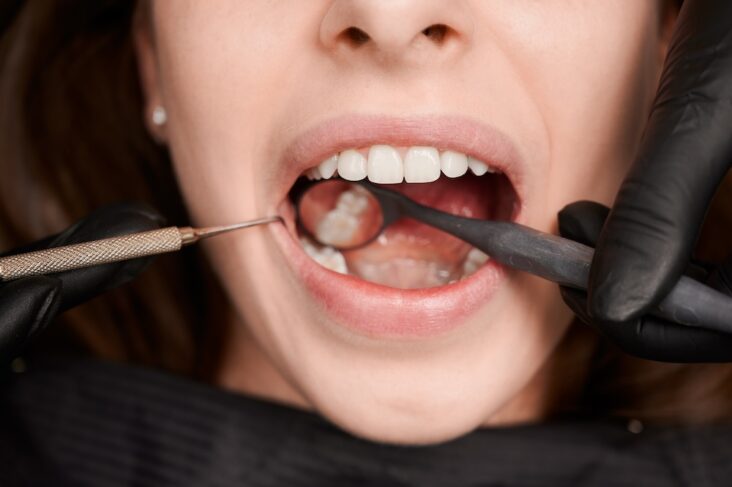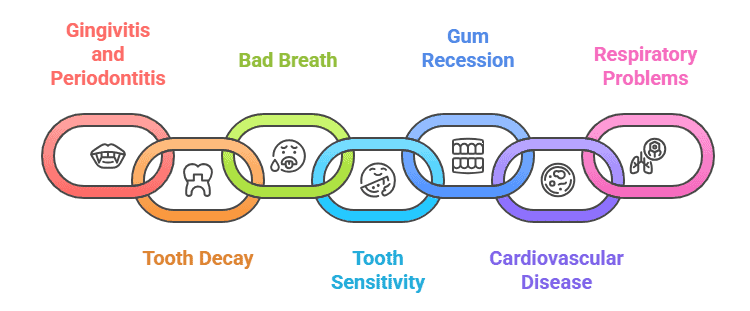Key Takeaways: Dental Tartar: Causes, Symptoms, and Effective Removal Treatments
- Dental tartar is hardened plaque that sticks firmly to teeth and gumlines, requiring professional cleaning for removal.
- Common symptoms include tooth discoloration, rough texture, visible deposits, gum irritation, bad breath, and gum recession.
- Risk factors for tartar buildup include smoking, dry mouth, braces, older age, and poor oral hygiene habits.
- Untreated tartar can lead to complications like tooth decay, bad breath, sensitivity, gum recession, and even heart or respiratory issues.
- Professional treatments such as scaling, root planing, and periodontal therapy are the most effective ways of dental tartar removal and protecting your long-term oral health.
Dental tartar is a common oral health issue that often goes unnoticed until it starts causing visible changes in your teeth and gums. Many people confuse it with plaque, but tartar is a hardened form of plaque that requires professional removal.
If left untreated, tartar can lead to gum disease, cavities, and even more serious health problems. This article helps you understand its causes, symptoms, and the best dental tartar treatment options available.
What is Dental Tartar?
Dental tartar, also known as calculus, is a hardened layer of plaque that sticks to the surface of teeth and along the gumline. Unlike soft plaque that can be removed by brushing and flossing, you can’t dissolve dental tartar at home. This is because the tartar bonds strongly to the teeth and requires professional cleaning to remove.
What is Dental Tartar Made of?
Dental tartar is made up of mineralized plaque, bacteria, food particles, and saliva proteins. Over time, the minerals in saliva harden plaque, forming rough deposits that trap even more bacteria.
What are the Causes of Dental Tartar?
Tartar is essentially the buildup of dental plaque hardened by the minerals in saliva. Several factors contribute to its formation. Common causes include:
- Smoking: Cigarette smoking encourages plaque buildup and makes tartar form more quickly. Also, in addition to staining, smoking weakens gum health.
- Eating & Drinking: Sugary and starchy foods, along with coffee, tea, or soda, feed bacteria that lead to tartar.
- Accumulation of Plaque Under the Gumline: When plaque extends under the gums, it hardens into tartar that irritates gum tissues.
- Mineralization: Saliva naturally contains calcium and phosphate, which harden plaque into tartar.
- Damage or Injury: Traumas such as tooth damage or gum injury can create rough surfaces that make tartar formation easier.
- Bad Dental Hygiene: Skipping brushing and flossing allows plaque to stay on teeth longer, increasing tartar buildup.
What are the Warning Signs of Dental Tartar?
Tartar buildup doesn’t always hurt, but it often brings noticeable changes to your teeth and gums. The symptoms usually start mild and become more visible if left untreated. Here are some common symptoms to look out for:
- Tooth Discoloration: Tartar often appears as yellow or brown stains that regular brushing and toothpaste cannot remove. These stains make teeth look dull and unhealthy.
- Rough or Gritty Texture: When tartar hardens, teeth may feel uneven or rough to the touch. This texture can make food particles stick more easily.
- Visible Deposits: Hardened tartar often forms around the gumline, showing up as a chalky or crusty buildup. In severe cases, it may cover larger areas of teeth.
- Gum Irritation: Swollen, red, or tender gums are common signs of tartar buildup. You may also notice bleeding when brushing or flossing.
- Persistent Bad Breath: Bacteria trapped within tartar release foul-smelling toxins, leading to chronic bad breath that doesn’t go away easily.
- Receding Gums: Over time, tartar pushes against the gumline, causing gums to slowly pull away from teeth. This can expose tooth roots and increase sensitivity.
Who is More Likely to Develop Dental Tartar?
Anyone can get tartar, but some people are more at risk. Smokers often develop tartar faster because nicotine and tobacco chemicals stain teeth and speed up buildup. People with dry mouth are also vulnerable since less saliva reduces the mouth’s natural defense against plaque.
Those with braces or dental appliances may struggle to clean thoroughly, making tartar more likely. Older adults face a higher risk due to age-related changes in saliva and oral health. And finally, individuals with poor oral hygiene habits are the most prone, as skipping brushing and flossing allows plaque to harden into tartar quickly.
What are the Complications of Not Having Dental Tartar Cleaning?
Leaving tartar untreated doesn’t just affect the appearance of your teeth. It can create serious oral health problems and even contribute to issues beyond oral health. Here’s what can happen if tartar is not professionally removed:
- Gingivitis and Periodontitis: When tartar builds along the gumline, it irritates the gums and leads to inflammation, which is the first stage of gingivitis. If left untreated, this condition may progress to periodontitis, a more advanced gum disease that can damage bone and lead to tooth loss.
- Tooth Decay: Tartar traps harmful bacteria that produce acids, slowly eroding the enamel and creating cavities. Preventive steps, along with treatments like restorative dentistry, can help stop decay before it becomes severe.
- Bad Breath: Persistent bad breath (halitosis) is often caused by bacteria that live inside tartar deposits. Since brushing and mouthwash cannot reach deep into hardened tartar, only a professional dental cleaning can resolve the issue.
- Tooth Sensitivity: Gum recession and enamel erosion caused by tartar expose the dentin layer of the teeth, leading to sharp sensitivity. If left untreated, sensitivity may worsen and require professional treatment to strengthen and protect the teeth.
- Gum Recession: As tartar presses against the gums, they begin to pull away from the teeth, creating pockets that expose tooth roots. This not only increases sensitivity but also raises the risk of infection and the need for periodontal treatment.
- Cardiovascular Disease: Studies suggest that bacteria from untreated tartar and gum disease can travel through the bloodstream, potentially increasing the risk of heart disease and other cardiovascular conditions.
- Respiratory Problems: Oral bacteria from tartar can also be inhaled into the lungs, where they may aggravate conditions like bronchitis or increase susceptibility to lung infections such as pneumonia.
How is Tartar Diagnosed by Dentists?
Dentists diagnose tartar during a routine dental exam by visually inspecting teeth and gums. They may also use dental instruments to feel for rough deposits that brushing cannot remove.
How Do Dentists Remove Dental Tartar?
Professional dental tartar removal is the safest and most effective way to keep your teeth and gums healthy. During a dental visit, your dentist or hygienist uses specialized techniques to clean areas that regular brushing and flossing can’t reach. Here are the main steps involved:
- Professional Dental Cleaning: A routine cleaning removes plaque and tartar buildup, leaving teeth smoother and easier to keep clean. This preventive care also helps reduce the risk of cavities and gum disease.
- Scaling: Using special instruments, the dentist scrapes away hardened tartar from above and below the gumline. This helps relieve gum irritation, lowers inflammation, and protects the bone and tissues that support your teeth.
- Root Planing: To eliminate rough spots, the dentist needs to smooth the surface of the root because bacteria tend to cling here. This process is called root planning. It is done after scaling. Planing allows the gums to heal and reattach firmly to the teeth, strengthening overall gum health.
- Gum Disease Treatments: For advanced cases of tartar buildup that have already led to gum problems, deep cleaning is combined with periodontal therapy. These treatments fight infection, control disease progression, and help restore healthier gums.
Ignoring tartar can lead to gum disease, bad breath, and even tooth loss. At Coral Dental Care, we use advanced techniques to remove dental tartar gently and effectively, protecting both your smile and your health.
Don’t wait, book your dental tartar cleaning now.
Frequently Asked Questions
-
Can dental cleaning remove tartar?
Yes. Professional dental cleanings are the only reliable way to remove tartar. Dentists and hygienists use special tools to safely scrape off hardened deposits that regular brushing or flossing can’t remove.
-
Can dental floss remove tartar?
No. Dental floss is excellent for preventing tartar by cleaning food and plaque between teeth, but once plaque hardens into tartar, floss alone cannot remove it. You need a dental cleaning for complete removal.
-
How to remove tartar with a dental pick?
While some at-home kits are sold, using a dental pick on your own can damage gums and enamel. Dental picks are sharp tools designed for professional use. So, it’s best to let a dentist handle tartar removal with sterile, safe instruments.
-
How to get rid of dental tartar at home?
You can’t fully remove tartar at home, but you can slow its buildup by:
- Brushing twice daily with fluoride toothpaste
- Flossing once a day
- Using an antibacterial mouthwash
- Reducing sugary and starchy foods
Only a dentist can do the job of dental tartar removal safely.

Dr. Anu Isaac, DMD, runs a successful dental practice in Salem, MA. Dr. Isaac strives for quality on a daily basis and this commitment to quality is reflected in her constant pursuit of advanced training. Her firm belief that even experts need to stay updated about what’s new in the dental field, enables her to provide every patient with optimal oral care. As the founder of Coral Dental Care, she is dedicated to creating healthy, beautiful smiles for her patients and also to educating dental and non-dental community with her engaging articles on all things related to oral health, recent dental innovations, and latest treatment modalities.




